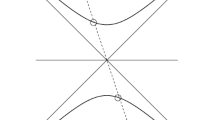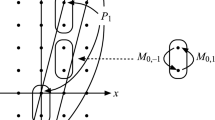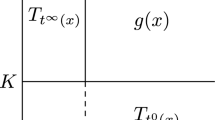Abstract
We introduce a family of spaces called critical varieties. Each critical variety is a subset of one of the positroid varieties in the Grassmannian. The combinatorics of positroid varieties is captured by the dimer model on a planar bipartite graph G, and the critical variety is obtained by restricting to Kenyon’s critical dimer model associated to a family of isoradial embeddings of G. This model is invariant under square/spider moves on G, and we give an explicit boundary measurement formula for critical varieties which does not depend on the choice of G. This extends our recent results for the critical Ising model, and simultaneously also includes the case of critical electrical networks. We systematically develop the basic properties of critical varieties. In particular, we study their real and totally positive parts, the combinatorics of the associated strand diagrams, and introduce a shift map motivated by the connection to zonotopal tilings and scattering amplitudes.
























Similar content being viewed by others
Notes
Strictly speaking, we have \({\text {wt}}_{\varvec{\theta }}(e)=\frac{1}{2i}{\text {wt}}_{\textbf{t}}(e)\) for all non-boundary \(e\in E(G)\), but this rescaling does not affect the boundary measurements since \({\text {wt}}_{\textbf{t}}\) and \({\text {wt}}_{\varvec{\theta }}\) are gauge-equivalent; see the proof of Lemma 5.9.
By linearity of Ohm’s and Kirchhoff’s laws, knowing \(\Lambda ^{{\mathbb {T}}}_{p,q}\) for all \(1\leqslant p,q\leqslant N\) allows one to solve the more general problem: for any known voltages that are applied to the boundary vertices, one finds the resulting currents flowing through each boundary vertex.
More precisely, Lam’s embedding lands in \({\text {Gr}}_{\geqslant 0}(N-1,2N)\). To get an element of \({\text {Gr}}_{\geqslant 0}(N+1,2N)\), one needs to apply the duality discussed in Sect. 3.2.
The point \(X_0^{({k,n})}\) is the unique element of \({\text {Gr}}_{\geqslant 0}(k,n)\) satisfying \(S(X_0^{({k,n})})=X_0^{({k,n})}\), where \(S:{\text {Gr}}_{\geqslant 0}(k,n)\rightarrow {\text {Gr}}_{\geqslant 0}(k,n)\) is the cyclic shift automorphism discussed in Sect. 3.1.
When (un)contracting a degree 2 interior vertex, we always assume that both edges incident to it have weight 1; this is always achievable by applying gauge transformations.
We thank Lauren Williams for comments motivating the below results.
The name is explained by the fact that if \({\varvec{\theta }}\) and \({\textbf{t}}\) are related by (5.1) then up to a simple transformation, the rows of \(F_{f,{\textbf{t}}}\) yield the Fourier coefficients of \(\varvec{\gamma }_{f,{\varvec{\theta }}}(t)\), viewed as a \(2\pi \)-periodic function of t.
In order to invoke [OPS15, Proposition 9.8] one needs to assume that the Grassmann necklace of f is connected. However, even when it is not connected, the Grassmann necklace curve may be deformed slightly into a simple closed curve surrounding \(\Sigma _k(G)\); see the discussion around [BW20, Definition 4.4].
References
Arkani-Hamed, N., Bourjaily, J., Cachazo, F., Goncharov, A., Postnikov, A., Trnka, J.: Grassmannian Geometry of Scattering Amplitudes. Cambridge University Press, Cambridge (2016)
Arkani-Hamed, N., Lam, T., Spradlin, M.: Positive configuration space. arXiv:2003.03904v2 (2020)
Arkani-Hamed, N., Trnka, J.: The amplituhedron. J. High Energy Phys. 2014(10), 30 (2014)
Ardila, F., Rincón, F., Williams, L.: Positroids and non-crossing partitions. Trans. Am. Math. Soc. 368(1), 337–363 (2016)
Baxter, R.J.: Solvable eight-vertex model on an arbitrary planar lattice. Philos. Trans. R. Soc. Lond. Ser. A 289(1359), 315–346 (1978)
Baxter, R.J.: Free-fermion, checkerboard and \({ Z}\)-invariant lattice models in statistical mechanics. Proc. R. Soc. Lond. Ser. A 404(1826), 1–33 (1986)
Britto, R., Cachazo, F., Feng, B., Witten, E.: Direct proof of the tree-level scattering amplitude recursion relation in Yang–Mills theory. Phys. Rev. Lett. 94(18), 181602, 4 (2005)
Bott, R., Taubes, C.: On the self-linking of knots. J. Math. Phys. 35(10), 5247–5287 (1994)
Balitskiy, A., Wellman, J.: Flip cycles in plabic graphs. Sel. Math. (N.S.), 26(1), Paper No. 15, 29 (2020)
Chelkak, D., Laslier, B., Russkikh, M.: Dimer model and holomorphic functions on t-embeddings of planar graphs. arXiv:2001.11871v1 (2020)
Corteel, S., Williams, L.K.: Tableaux combinatorics for the asymmetric exclusion process and Askey–Wilson polynomials. Duke Math. J. 159(3), 385–415 (2011)
Dubédat, J.: Exact bosonization of the Ising model. arXiv:1112.4399v1 (2011)
Fomin, S., Pylyavskyy, P., Shustin, E., Thurston, D.: Morsifications and mutations. arXiv:1711.10598v3 (2017)
Fomin, S., Zelevinsky, A.: Cluster algebras. I. Foundations. J. Am. Math. Soc. 15(2), 497–529 (2002)
Galashin, P.: Plabic graphs and zonotopal tilings. Proc. Lond. Math. Soc. (3) 117(4), 661–681 (2018)
Galashin, P.: Poset associahedra. arXiv:2110.07257v1 (2021)
Galashin, P.: Symmetries of stochastic colored vertex models. Ann. Probab. 49(5), 2175–2219 (2021)
Galashin, P.: Totally nonnegative critical varieties. arXiv:2110.08548v1 (2021)
Galashin, P.: A formula for boundary correlations of the critical Ising model. Probab. Theory Relat. Fields 182(1–2), 615–640 (2022)
Galashin, P., Karp, S.N., Lam, T.: Regularity theorem for totally nonnegative flag varieties. J. Am. Math. Soc. 35(2), 513–579 (2021)
Galashin, P., Karp, S.N., Lam, T.: The totally nonnegative Grassmannian is a ball. Adv. Math., 397, Paper No. 108123, 23 (2022)
Galashin, P., Lam, T.: Positroid varieties and cluster algebras. Ann. Sci. Éc. Norm. Supér. arXiv:1906.03501v1 (2019, to appear)
Galashin, P., Lam, T.: Parity duality for the amplituhedron. Compos. Math. 156(11), 2207–2262 (2020)
Galashin, P., Lam, T.: Positroids, knots, and \(q,t\)-Catalan numbers. arXiv:2012.09745v2 (2020)
Galashin, P., Pylyavskyy, P.: Ising model and the positive orthogonal Grassmannian. Duke Math. J. 169(10), 1877–1942 (2020)
Galashin, P., Postnikov, A., Williams, L.: Higher secondary polytopes and regular plabic graphs. arXiv:1909.05435v1 (2019)
Karp, S.N.: Sign variation, the Grassmannian, and total positivity. J. Combin. Theory Ser. A 145, 308–339 (2017)
Karp, S.N.: Moment curves and cyclic symmetry for positive Grassmannians. Bull. Lond. Math. Soc. 51(5), 900–916 (2019)
Kenyon, R.: Tiling a polygon with parallelograms. Algorithmica 9(4), 382–397 (1993)
Kenyon, R.: The Laplacian and Dirac operators on critical planar graphs. Invent. Math. 150(2), 409–439 (2002)
Kenyon, R., Lam, W.Y., Ramassamy, S., Russkikh, M.: Dimers and Circle patterns. arXiv:1810.05616v2 (2018)
Knutson, A., Lam, T., Speyer, D.E.: Positroid varieties: juggling and geometry. Compos. Math. 149(10), 1710–1752 (2013)
Kostant, B.: Flag manifold quantum cohomology, the Toda lattice, and the representation with highest weight \(\rho \). Sel. Math. (N.S.) 2(1), 43–91 (1996)
Kenyon, R.W., Propp, J.G., Wilson, D.B.: Trees and matchings. Electron. J. Combin. 7, Research Paper 25, 34 (2000)
Lam, T.: Totally nonnegative Grassmannian and Grassmann polytopes. In: Current Developments in Mathematics 2014, pp. 51–152. Int. Press, Somerville, MA (2016)
Lam, T.: Electroid varieties and a compactification of the space of electrical networks. Adv. Math. 338, 549–600 (2018)
Lukowski, T., Parisi, M., Williams, L.K.: The positive tropical Grassmannian, the hypersimplex, and the m=2 amplituhedron. arXiv:2002.06164v2 (2020)
Lusztig, G.: Total positivity in reductive groups. In: Lie Theory and Geometry, volume 123 of Progr. Math., pp. 531–568. Birkhäuser Boston, Boston, MA (1994)
Lusztig, G.: Introduction to total positivity. In: Positivity in Lie Theory: Open Problems, volume 26 of De Gruyter Exp. Math., pp. 133–145. de Gruyter, Berlin (1998)
Mercat, C.: Discrete Riemann surfaces and the Ising model. Commun. Math. Phys. 218(1), 177–216 (2001)
Marsh, R.J., Scott, J.S.: Twists of Plücker coordinates as dimer partition functions. Commun. Math. Phys. 341(3), 821–884 (2016)
Muller, G., Speyer, D.E.: The twist for positroid varieties. Proc. Lond. Math. Soc. (3) 115(5), 1014–1071 (2017)
Suho, O., Postnikov, A., Speyer, D.E.: Weak separation and plabic graphs. Proc. Lond. Math. Soc. (3) 110(3), 721–754 (2015)
Postnikov, A.: Total positivity, Grassmannians, and networks. Preprint, http://math.mit.edu/~apost/papers/tpgrass.pdf (2006)
Parisi, M., Sherman-Bennett, M., Williams, L.: The m=2 amplituhedron and the hypersimplex: signs, clusters, triangulations, Eulerian numbers. arXiv:2104.08254v3 (2021)
Postnikov, A., Speyer, D., Williams, L.: Matching polytopes, toric geometry, and the totally non-negative Grassmannian. J. Algebraic Comb. 30(2), 173–191 (2009)
Rietsch, K.: Totally positive Toeplitz matrices and quantum cohomology of partial flag varieties. J. Am. Math. Soc. 16(2), 363–392 (2003)
Simion, R.: A type-B associahedron. volume 30, pp. 2–25 (2003). Formal power series and algebraic combinatorics (Scottsdale, AZ, 2001)
Shende, V., Treumann, D., Williams, H., Zaslow, E.: Cluster varieties from Legendrian knots. Duke Math. J. 168(15), 2801–2871 (2019)
Talaska, K.: A formula for Plücker coordinates associated with a planar network. Int. Math. Res. Not. Art. ID rnn081 (2008)
Acknowledgements
I am indebted to Pasha Pylyavskyy for his numerous contributions at various stages of the development of [Gal22], where the boundary measurement formula was first discovered in the context of the Ising model. The generalization to the Grassmannian level was inspired by the results of [CLR20, KLRR18], presented by Marianna Russkikh at the “Dimers in Combinatorics and Cluster Algebras” conference at the University of Michigan. I thank Marianna for bringing these results to my attention, and also thank the organizers of the conference (Sebastian Franco, Gregg Musiker, Richard Kenyon, David Speyer, and Lauren Williams) for making such an interaction possible. Finally, I am grateful to Lauren Williams and to the anonymous referee for their valuable comments on the first version of the text.
Author information
Authors and Affiliations
Corresponding author
Additional information
Communicated by P. Francesco
Publisher's Note
Springer Nature remains neutral with regard to jurisdictional claims in published maps and institutional affiliations.
P. G. was supported by an Alfred P. Sloan Research Fellowship and by the National Science Foundation under Grants No. DMS-1954121 and No. DMS-2046915.
Rights and permissions
Springer Nature or its licensor (e.g. a society or other partner) holds exclusive rights to this article under a publishing agreement with the author(s) or other rightsholder(s); author self-archiving of the accepted manuscript version of this article is solely governed by the terms of such publishing agreement and applicable law.
About this article
Cite this article
Galashin, P. Critical Varieties in the Grassmannian. Commun. Math. Phys. 401, 3277–3333 (2023). https://doi.org/10.1007/s00220-023-04718-5
Received:
Accepted:
Published:
Issue Date:
DOI: https://doi.org/10.1007/s00220-023-04718-5




